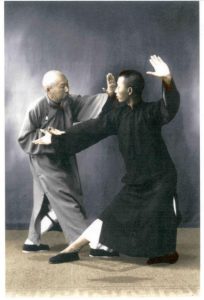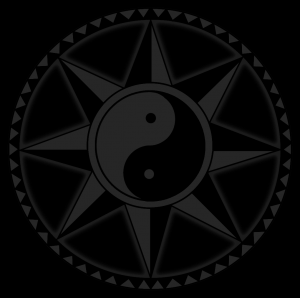Tai Chi Chuan
Why Holistic and Why the Martial Arts?
Tai Chi Chuan covers a wide range of training concepts, Tai Chi schools train different things and also in different ways. The Shi Zen Do School offers both holistic and Martial arts training, the student is free to choose, the student decides what they want to practice. Training in the martial art will help with the upstanding of correct postures and alignment why the art of Tai Chi is performed in the way it is. The holistic side of the art and the health benefits it bring is from the understanding of the art. Chinese arts have two sides to their training, health, wellbeing and martial, as one teacher quoted “A bicycle has two wheels”
To understand the martial arts side you have to be able to utilize the principles and concepts of Tai Chi Chuan and be able to grasp its function by developing the postures with the correct weight distribution and body angles coupled with alignment. This will build strength and softness within the body, will have the desired effect of powerful postures strung together in an unbroken flow of movement; with the added use of breathing together with mind moving mediation is developed. The Yi (mind) moves the Chi (energy). Tai Chi Chuan is the Martial art side, chuan translates as fist or function. The student desides which path to take.
Each student follows his or her own interests and the curriculum serves only as a guide for the Instructor and student to monitor progress.
Tui Shou
Single Hand
Single Pushing hand drills are the concept of sensitivity and understanding the varying forces applied onto you. Within this training, adhere, stick, connect and follow are developed, thus enabling you to monitor the subtle forces in your partner’s hand. The push is directed at your centre with a small amount of force; the receiver then redirects this force away from their centre to the corner then redirects the force back to their partner. Two students work together co-coordinating the force in a figure of eight pattern linking the arms to the waist. Both partners are receiving, negating and deflecting using a subtle force in a continuous cycle using the body, waist and legs to develop each other’s skill level. Once the basic pattern of movement has been learnt then the process of developing real skill begins. Through the pushing hands method you cultivate a deeper understanding of the inherent softness and sensitivity within this drill. Adhere, Stick, connect and follow are the principles skills under development within this partnered drill.
Double Push Hands
This is the process of two hands training, the double push hands is the concept of grasp the birds tail, section one of part one. The primary hands and the corner hands are utilised and developed through partnered training. This is similar to the single push hands excepted here two circles are used.
Vertical Push Hands
Again the concept of sensitivity and attaching is trained. The vertical push hands training method develops the Kua (Hip crease) point. The Kua is a very important point connection, it links the leg to the body enabling a flow of movement to the waist, it unites upper and lower.
Single Aun Double Aun Push
First trained as a single push i.e. The monitoring hands spiral around the partners arms and onto the shoulder then push, partner then responds back.
Dynamic Tui Shou
Two person partnered training developing strength and projection. Here the joints are developed, the concept of pushing through and beyond your partner. Grounding is also cultivated so as the force can freely flow through the structures of the body. sometimes refered to Yang push.
Seven Pearl Body Push
Developing sensitivity with demonstration of body structure and stability applied with softness. Tai Chi’s major folding points of the body are, two Shoulders, Chest folding back, Abdomen, Rotation of the two hips and the Shoulder folding diagonally forwards. These exercises teach flexibility, with the idea of the body being sensitive to forces applied against it. The student learns to adjust the body through the core rotational points of the body whilst keeping good alignment.
Wall Push
Projecting your partner to a matted wall, Aun, is used here to uproot your partner to push them away, this is performed softly, could use other parts of the body, such as should,hip or back.
Yin Yang Form
Clearly separates the substantial and unsubstantial, weighting sifting from one posture to the next. The Yin Yang form is a useful way to develop the smooth flowing movements associated with Tai Chi Chuan and define the postures.
Spiral Form
Spiral form teaches how to feed your intent into the opponent or deflect the opponent’s attack aimed at you. The spiral form is like a cone of spiralling force driving inwards or outwards, from foot to hand and hand to foot, there are also other uses in the spiral form.
Chin Na
Joint manipulation, locks and immobilising techniques linked into unbroken flow with a partner. Chin Na teaches the student how to apply various holds on the wrist, elbow, and shoulder; these techniques are trained and developed on both sides of the body. Once Chi Na has been learnt and the skill level sufficient this is then added to the push hands training, whereas the student learns when to place the manipulation by blending and bending to the incoming force. Chin Na is a responsive defence to neutralise your attacker.
Ta Lu
Two-person form developing the four corner hands. Pull-down, Split, Elbow-stroke and shoulder stroke, sometimes refered to as the Great Pull. This two person form takes the student a little closer to Tai Chi Chuan self-defence concept.
San Shou
Key to unlocking the free style Tai Chi Chuan form, used for self- defence training, utilising self-defence concepts with a training partner, performed in a unbroken flowing freestyle sequence, striking, kicking, grapping, pushing, locking and vital point attack all trained.
8 Principles of Movement
Eight principles of movement through the body, there are three on the leg, the ankle, knee and hip a further three on the arm, wrist, elbow and should. The last two are the top of the spine, the neck and the lower spine, the waist. These eight points correspond to the Shizendo Mon and are integral to understanding the art and associated principles to this system.

